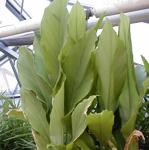Turmeric (Curcuma longa L.)
Turmeric (Curcuma longa L.), is a cultivated member of the Zingiberaceae (ginger) family known both for its culinary and medicinal uses. Turmeric is propagated only vegetatively because it is a sterile hybrid between wild Curcuma species, probably between Curcuma aromatica and closely related species such as Curcuma petiolata or Curcuma aurantiaca. The thousands of cultivars of turmeric that exist in south and southeast Asia may have resulted in part from independent hybridization events. The actual origin of turmeric is still under investigation by botanists. Turmeric has been in use in southern Asia for more than 2500 years as a dye, medicine, and spice, and is now cultivated in tropical regions around the globe. The island of Hawaii produces most of the organic turmeric available in the United States.
The plant, which consists of an underground creeping rhizome, a shallow root system, and numerous aerial shoots, grows to about 1 meter tall, with long plain-green oblong leaves that originate from buds off of the growing rhizome. Related Curcuma species have colored midribs or veins on the leaves. “True” turmeric does not have coloration on the leaves or on the inflorescence, which is green and white, with yellow and white flowers.
The rhizomes (underground stems) are the economically, culinary and medicinally important parts of the plant. The rhizomes of true turmeric typically do not have a strong flavor, although related species (such as C. aromatica and C. aurantiaca) that are sometimes labeled as turmeric do have strong aromatic and bitter tastes. The plant’s most interesting medicinal compounds, which are found at highest levels in the rhizomes are the curcuminoids. The curcuminoids, particularly curcumin, are probably the most well-known of these “specialized metabolites” as they are responsible for the rhizome’s characteristic deep yellow to orange color. Curcuminoids can make up to about 5% of the rhizome’s dry weight. They are also a focus of a number clinical research trials.
Turmeric has been used in traditional medicine for numerous ailments including stomach and liver problems and diabetes, and to treat inflammation. It has also been used externally on wounds, insect bites, and to relieve itchiness. Turmeric extracts have been shown to have antioxidant, anti-cancerous, anti-inflammatory and other important properties. Curcumin has been implicated in many of these beneficial properties of turmeric. As a result, it has been the focus of research into treatment of (among others) Alzheimer’s disease, diabetes, arthritis, and different types of cancers.
There remains much to learn regarding which of turmeric’s numerous specialized metabolites contribute to its specific beneficial properties, and how these compounds work in the body.
Additional sites that may be of interest:
http://www.kew.org/plant-cultures/plants/turmeric_landing.html
